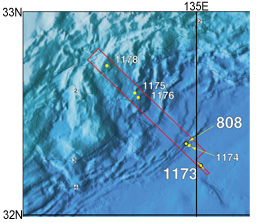 |
The ASCII datasets contain pressure values measured at 10-min intervals at the seafloor
and several subseafloor depths in two "Advanced CORK" hydrologic observatories installed
by ODP in 2001 at Sites 808I and 1173B in the Nankai Trough subduction zone. The datasets
were downloaded from logger memory using Japanese research submersibles at irregular
intervals of 1-2 years. Currently there are 14 total datasets as follows: downloads
at 808I in 2002, 2003, 2004, 2006, 2007, 2008, 2011, and 2012; downloads at 1173B
in 2002, 2004, 2006, 2007, 2011, and 2012. They should be of interest to scientists
studying seismogenic processes at subduction zones. Please note that much of the data
from 808I may be compromised by the lack of seal for the central bore. In addition,
several of the valves on both installations were bumped open by a reentry camera frame
during deployment, so the first year's installment of data from both sites was compromised
until the valves were closed during the 2002 Kaiko operations. There are separate
data files for each of the downloads. Each data file has a header of basic metadata
that describes the contents of the columns and the respective checks on logger clock
drift. Typically, the clock drift was checked just before each download, and the clocks
were then reset to UTC immediately after the respective downloads. In three cases,
the records of the logger times checks have been misplaced and the drifts computed
from other clock checks (consistent from year to year at each site, order 1-2 minutes
per year) are reported. Note that the times in the data files have not been corrected
for the clock drift. Also, during some of the download operations, there were attempts
to calibrate the relative offsets among gauges by opening the seafloor valves to apply
seafloor pressure to all the gauges. These are not reflected in the main data files.
The installations have battery power for 10-15 years of operation, longer with planned
addition of supplemental batteries, so there should be future downloads to add to
the archive. There are likely to be future JAMSTEC download opportunities at unpredictable
intervals, hopefully every 1-2 years. At approximately 5 Mb/yr, future datasets should
be approximately 5-10 Mb in size. |